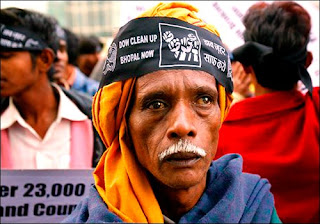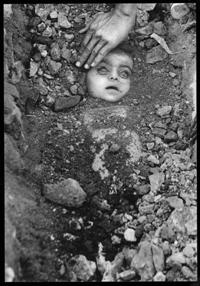BHOPAL GAS TRAGEDY - A Summary with Images
1 | Activists of Amnesty International wear masks representing victims of the Bhopal gas tragedy during a demonstration outside the European headquarters of Dow Chemicals in Brussels on Wednesday. The protest took place to commemorate the 25th anniversary of the tragedy that has subsequently claimed over 15,000-20,000 lives. |
2 | Fourteen-year-old Suraj Raghuwanshi is comforted by her mother in a rehabilitation centre for children who were born with mental and physical disabilities in Bhopal on Wednesday. Government statistics compiled after 1994 concluded that at least 100,000 people living near the factory in Madhya Pradesh were chronically sick, with more than 30,000 residing in areas with contaminated water. |
3 | Children climb up a wall with murals which surrounds the Union Carbide Corp pesticide plant in Bhopal on Wednesday. The Union Carbide Corporation paid $470 million as compensation to the Indian government in 1989. |
4 | Handicapped children sing during a ceremony in Bhopal to mark the 25th anniversary of the Bhopal Gas tragedy. Bhopalis and environmental groups say many more people have been harmed since then by pollutants seeping out of the plant site into ground water, which they contend have caused health problems for nearby residents including cancer, growth retardation and dizziness. |
5 | A woman holds a candle during a vigil to mark the 25th anniversary of the Bhopal gas disaster in Bhopal. More than 600,000 people have been affected so far. |
6 | Women collect water in a slum area next to the Union Carbide Corp pesticide plant in Bhopal. Campaigners say the effects of the gas leak continue to this day as Bhopal has an unusually high incidence of children with birth defects and growth deficiency, as well as cancers, diabetes and other chronic illnesses. |
7 | A woman walks with her child in a slum area near the Union Carbide Corp pesticide plant in Bhopal. Dow Chemicals, which bought the company in 1999, says the $470-million settlement resolved all existing and future claims against the company. |
8 | Eleven-year-old Salu Raikwar, who was born with six fingers on both hands, walks in a slum area next to the Union Carbide Corp pesticide plant in Bhopal. The state government of Madhya Pradesh is now responsible for the pesticide plant site. |
9 | Mothers wait with their children for treatment in a rehabilitation centre for children who were born with mental and physical disabilities in Bhopal. Groundwater in areas around the Bhopal gas tragedy site contain almost 40 times more pesticides than allowed under the Indian standards, the Centre for Science and Environment has claimed. |
10 | Elderly woman Laccho Bai, whose eyes were damaged by the 1984 Union Carbide gas leak, sits on the dirt floor of her home, a shack of wooden planks propped against a brick wall with a tin roof, in Bhopal. Laccho Bai's life has gone from bad to worse in the 25 years since the Bhopal gas tragedy. Like many other survivors living close to the Union Carbide facility, she and her family saw none of the multi-million dollar settlement package meant to help those affected. |
11 | Schoolchildren hold placards during a protest against the delay in justice for Bhopal gas tragedy victims in Bangalore, on the 25th anniversary of one of the world's worst industrial accidents. In a bid to keep the memory of Bhopal alive, Madhya Pradesh, the state where the rusting factory on 67 acres is located, has suggested turning the site into a museum like those in Hiroshima, Chernobyl or New York's ground zero. |
12 | French writer and activist Dominique Lapierre gestures during a press conference about the Bhopal gas tragedy, in Bhopal on Tuesday. The royalties from Lapierre's book 'It was Five Past Midnight in Bhopal' will go to the Sambhavna clinic in Bhopal which provides free medical treatment to the victims of the 1984 Union Carbide gas disaster. |
13 | Activists and victims of the Bhopal gas disaster participate in a torch procession towards the abandoned Union Carbide factory on the eve of 25th anniversary of the disaster, in Bhopal on Wednesday. Residents have called repeatedly for Michigan-based Dow Chemical to mount a thorough cleanup. They say the toxic waste in and around the plant -- estimated at 350 tons and never properly treated -- continues to kill crops, pollute groundwater and cause cancer, birth defects, neurological damage, chaotic menstrual cycles and mental illness. |
14 | Victims of the Bhopal gas disaster shout slogans during a torch procession towards the abandoned Union Carbide factory on the eve of 25th anniversary of the disaster, in Bhopal on Wednesday. Dow says it never operated the Bhopal plant and bears no responsibility; Union Carbide said on its website that the accident was a terrible tragedy but that it met its obligations. |
15 | A woman gives her son, who was born with mental and physical disabilities, a candle during a ceremony ahead of the 25th anniversary of Bhopal gas disaster in Bhopal on Tuesday. The chemical giant said an investigation that it funded found the accident resulted from sabotage, a claim locals strongly dispute. |
16 | On a Friday, Nov. 20, 2009 - photograph, a physiotherapist holds the leg of a seven year old child at a clinic run by a non governmental organization to cater to victims of the gas tragedy in Bhopal, India. Victims are angry at the government's indifference, which wasn't helped by a recent visit to the site by Environment Minister Jairam Ramesh who downplayed their health problems. |
17 | On Nov. 22, 2009 photograph, Apeksha Malviya cries at her home in Bhopal, India. |
18 | A volunteer works on a mural painting outside the Union Carbide factory in Bhopal. In recent days, victims' groups have organized marches, photo exhibitions, poetry readings, effigy burnings and a "benign buffet" in which government officials were invited to dine on "reactor residue quiche," "lime sludge mousse," "tar souffle" and other dishes made from the toxic waste that officials say is harmless. |
19 | Activists hold placard and a candle during a candle lit vigil on the eve of 25th anniversary the disaster, in Bhopal on Wednesday. |
20 | A torn and rotting glove is seen on the floor at the Union Carbide pesticide plant, 25 years after 40 tons of lethal methyl isocyanate (MIC) gas leaked from this same plant, in Bhopal. |
21 | A spider's web is seen spun on defunct machinery at the Union Carbide pesticide plant, 25 years after 40 tons of lethal methyl isocyanate (MIC) gas leaked from this same plant, in Bhopal. |
22 | Activists and victims hold candles during a candle lit vigil on the eve of 25th anniversary the disaster, in Bhopal on Wednesday. Activists say that thousands of children, born to parents directly exposed to the gas leak or poisoned by the contaminated water, are suffering from cleft lips, missing palates, twisted limbs. |
23 | In this Friday, Nov. 20, 2009 photograph, a patient complaining of severe joint pain and breathlessness waits to be treated by a doctor of the alternative system of medicine at a clinic run by a non governmental organization in Bhopal, India. |
24 | In this Friday, Aug. 7, 2009 photograph, Hira Lal, who has lost the ability to move and hear, lays on a makeshift bed outside his shanty in Bhopal. |
25 | In this Saturday Nov. 21, 2009 photograph, people carry potable water collected from inside the premises of Union Carbide factory in Bhopal, India. |
26 | Activists and survivors of the 1984 Bhopal gas leak disaster that killed and harmed thousands burn an effigy of Dow Chemical Co outside it's office in Noida, on the outskirts of New Delhi. |
27 | Activists and survivors of the 1984 Bhopal gas leak disaster that killed and harmed thousands of people burn an effigy of Dow Chemical Co outside its office in Noida, on the outskirts of New Delhi. |
28 | Activists and survivors of the 1984 Bhopal gas leak disaster protest against Dow Chemical Co outside its office in Noida, on the outskirts of New Delhi. For decades, survivors have been fighting to have the site cleaned up, but they say the efforts were slowed when Michigan-based Dow Chemical Co. took over Union Carbide in 2001. |
29 | In this Dec. 10, 1984 file photo, Warren M. Anderson, chairman of the board of Union Carbide, speaks in Danbury, Conn. after returning from Bhopal, India. An Indian court issued a warrant Friday, July 31, 2009, for Anderson, now 89, to answer charges related to the December 4, 1984 leak of 40 tonnes of poisonous gas that killed 10,000 people in Bhopal. OTHER RELATED IMAGES |



































